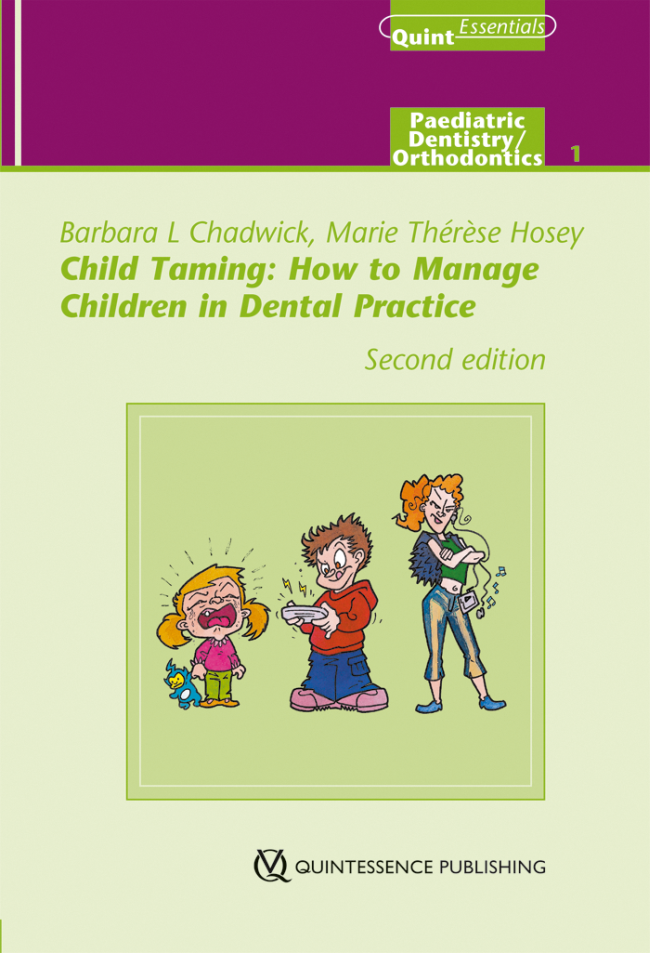David Simons / Cath Potter / Graham Temple
Hypnosis and Communication in Dental Practice
1st Edition 2007
Book
Hardcover, 280 pages, 1 illustrations
Language: English
Categories: Interdisciplinary, Pediatric Dentistry, Oral Surgery
Stock No.: 14131
ISBN 978-1-85097-116-0
QP United Kingdom
Product out of print.
Despite significant progress in the field of pain management, many people today still avoid seeing a dentist because of fear and anxiety. This book presents a philosophy for reducing patients' anxiety and putting them at ease, beginning the moment they call for an appointment. Combining clinical hypnosis techniques with specialized communication strategies (both verbal and nonverbal), the authors guide the entire dental team in every facet of patient interaction. Through instructional scripts and case histories, they offer specific techniques for managing fear, anxiety, and pain; sedation; smoking cessation; and treatment of children, among other topics.
Contents
Chapter 01. History and Development of Hypnosis in Medicine
Chapter 02. Theories and Nature of hypnosis
Chapter 03. Rapport in Dental Practice
Chapter 04. Demystifying Hypnosis
Chapter 05. Stage Hypnosis
Chapter 06. Communicating with Patients
Chapter 07. Induction
Chapter 08. Deepening
Chapter 09. Alerting
Chapter 10. Hypnotic Communication
Chapter 11. Ericksonian Suggestions
Chapter 12. Metaphors and Imagery
Chapter 13. Ego-strengthening
Chapter 14. Ideomotor Signalling
Chapter 15. Post-hypnotic Suggestions
Chapter 16. Anchoring
Chapter 17. Self-hypnosis
Chapter 18. Control of Bleeding
Chapter 19. Control of Salivation
Chapter 20. Management of Aphthous Ulceration
Chapter 21. Psychodynamic Therapy
Chapter 22. Abreaction and Affect Bridge
Chapter 23. Pain, Fear and Anxiety
Chapter 24. Management of Fear and Anxiety
Chapter 25. Management of Pain
Chapter 26. Introduction to Habit Management
Chapter 27. Bruxism
Chapter 28. Gagging
Chapter 29. Thumb Sucking and Nail Biting
Chapter 30. Smoking Cessation
Chapter 31. Hypnosis with Children
Chapter 32. Hypnosis as an adjunct to Sedation
Foreword
It's hard to escape the current debate about the emphasis of customer focus and care within the profession of dentistry. As dentists we exist for, and because of, our patients. We provide care for our patients who, if we get the product right, in turn reward us with loyalty and appreciation and the financial stability to continue to care.
Fundamental to our credibility as a profession which cares for its customers, and to overcoming barriers to that care, is the imperative for us and our dental teams to offer and provide an environment where anyone can happily, willingly and comfortably accept our advice and treatment and become a part of the community which looks after its oral health.
If we start, however, to look carefully at the needs of the population we find a huge cohort of people who don't access our services at all. There are a multitude of well documented reasons for that but many will certainly be anxious about attempting to start a relationship with a dentist, may be convinced that they are a "bad patient", may be scared that they just can't cope or may simply be frightened of the fear.
The attitude of the authors of this book is that most (if not all) can benefit from hypnosis provided that careful techniques and communication are used. Maybe by adding hypnosis and effective communication skills to our armoury of abilities we can begin to eliminate the compromises in care which are so often driven by the anxieties of our customers.
In this fascinating and encouraging book the authors have succeeded in practising what they preach. Whilst they invite you to build rapport and relationships with your patients in a way which is accessible, appropriate, ego strengthening and confidence building, they have written a book pitched perfectly at a level which is accessible, at a pace which is entirely appropriate and have developed a style which inspires confidence and an enthusiasm to use the skills you are learning.
When I was asked to write the foreword I was immediately reminded of my training in dental hypnosis many years ago with David Simons, which has so effectively coloured my own practice of dentistry, in the surgery and out, ever since. The skills I learned then constantly influence not only my communication with patients and colleagues but also interactions in every field of my work and for that I am deeply grateful. Whichever way you choose to use this book—perhaps as an introduction to your own first steps in hypnosis, as a revision tool, maybe as a means to understand the role of hypnosis in dentistry—you and your patients will certainly gain enormously from it.
Susie Sanderson; Chair, BDA Executive Board
Contents
Chapter 01. History and Development of Hypnosis in Medicine
Chapter 02. Theories and Nature of hypnosis
Chapter 03. Rapport in Dental Practice
Chapter 04. Demystifying Hypnosis
Chapter 05. Stage Hypnosis
Chapter 06. Communicating with Patients
Chapter 07. Induction
Chapter 08. Deepening
Chapter 09. Alerting
Chapter 10. Hypnotic Communication
Chapter 11. Ericksonian Suggestions
Chapter 12. Metaphors and Imagery
Chapter 13. Ego-strengthening
Chapter 14. Ideomotor Signalling
Chapter 15. Post-hypnotic Suggestions
Chapter 16. Anchoring
Chapter 17. Self-hypnosis
Chapter 18. Control of Bleeding
Chapter 19. Control of Salivation
Chapter 20. Management of Aphthous Ulceration
Chapter 21. Psychodynamic Therapy
Chapter 22. Abreaction and Affect Bridge
Chapter 23. Pain, Fear and Anxiety
Chapter 24. Management of Fear and Anxiety
Chapter 25. Management of Pain
Chapter 26. Introduction to Habit Management
Chapter 27. Bruxism
Chapter 28. Gagging
Chapter 29. Thumb Sucking and Nail Biting
Chapter 30. Smoking Cessation
Chapter 31. Hypnosis with Children
Chapter 32. Hypnosis as an adjunct to Sedation
Foreword
It's hard to escape the current debate about the emphasis of customer focus and care within the profession of dentistry. As dentists we exist for, and because of, our patients. We provide care for our patients who, if we get the product right, in turn reward us with loyalty and appreciation and the financial stability to continue to care.
Fundamental to our credibility as a profession which cares for its customers, and to overcoming barriers to that care, is the imperative for us and our dental teams to offer and provide an environment where anyone can happily, willingly and comfortably accept our advice and treatment and become a part of the community which looks after its oral health.
If we start, however, to look carefully at the needs of the population we find a huge cohort of people who don't access our services at all. There are a multitude of well documented reasons for that but many will certainly be anxious about attempting to start a relationship with a dentist, may be convinced that they are a "bad patient", may be scared that they just can't cope or may simply be frightened of the fear.
The attitude of the authors of this book is that most (if not all) can benefit from hypnosis provided that careful techniques and communication are used. Maybe by adding hypnosis and effective communication skills to our armoury of abilities we can begin to eliminate the compromises in care which are so often driven by the anxieties of our customers.
In this fascinating and encouraging book the authors have succeeded in practising what they preach. Whilst they invite you to build rapport and relationships with your patients in a way which is accessible, appropriate, ego strengthening and confidence building, they have written a book pitched perfectly at a level which is accessible, at a pace which is entirely appropriate and have developed a style which inspires confidence and an enthusiasm to use the skills you are learning.
When I was asked to write the foreword I was immediately reminded of my training in dental hypnosis many years ago with David Simons, which has so effectively coloured my own practice of dentistry, in the surgery and out, ever since. The skills I learned then constantly influence not only my communication with patients and colleagues but also interactions in every field of my work and for that I am deeply grateful. Whichever way you choose to use this book—perhaps as an introduction to your own first steps in hypnosis, as a revision tool, maybe as a means to understand the role of hypnosis in dentistry—you and your patients will certainly gain enormously from it.
Susie Sanderson; Chair, BDA Executive Board
Preface
This book is written by dentists for dentists and the whole dental team. Whether you are a student or an experienced practitioner you will find advice and instruction concerning vital aspects of your day to day interaction with patients. Excellent communication skills are an essential ingredient of patient care. When these skills are combined with hypnosis the benefits to patients are profound. There are few disciplines where the two link together as seamlessly and as effectively as they do in dental practice.
Despite the amazing advances in dental technology and pain management that have taken place over recent years dental treatment remains, both in folk-lore and in the minds of many patients, something to be feared, and it is vital that we do all we can to alleviate our patients' apprehension. In Hypnosis and Communication in Dental Practice, we will show you how you can reduce anxiety amongst your patients, and as a consequence work in a less stressed environment.
A common misconception is that hypnosis is time consuming. On the contrary, hypnosis can save a great amount of clinical time through the use of post-hypnotic suggestions and the various other strategies that we describe. Consequently you will find that overall your treatment of many patients will become speedier and much more efficient.
Hypnosis is not something that you use for a particular item of treatment as you might for example apply a topical anaesthetic. It influences everything you do, every word you speak, every gesture you make and every facial expression you display. Hypnosis in dental practice becomes a philosophy which pervades every aspect of your own behaviour, and importantly that of every member of your team. In Hypnosis and Communication in Dental Practice, we demystify clinical hypnosis, demonstrating that hypnosis is not in itself a therapy but that it is a way of providing therapy by enhancing communication, thus enabling suggestions and information to be better absorbed. In this way hypnosis can be used to stimulate new ways of thinking, feeling and behaving.
The processes that we will be describing in this book begin from the first moment that a patient hears of your practice. That first phone call and all the interactions that take place even before you and the patient meet will have a huge impact on your relationship, and consequently upon the ease with which you and the patient can work together. Within this complex interaction the roles that the receptionist, nurses and other members of the team have to play are of paramount importance. In effect all of them will contribute to the ease with which each individual patient will accept both hypnosis and dentistry with you.
Much of this book is about the use of words. We will be examining the ways in which your choice of words, the language you use in your dental practice, has a deep influence upon the comfort and well-being of your patients. To the nervous patient every word you use carries a suggestion, and many of these words will be construed in a negative way by an anxious patient. Dentists who have learned to use hypnosis observe how their language has altered for the better, not merely in the dental practice but also in their selection and usage of words in general conversation.
Similarly, in writing this book we have come to recognise the linguistic challenges of using a vocabulary which is equally applicable across genders and to all the members of the dental team be they dental practitioners, receptionists, dental nurses, dental hygienists or dental therapists. For this purpose, we have generally directed our remarks in this book to you, the reader, rather than using the style of third person, "the therapist." We hope that all your team, and particularly your nursing staff who can play such an important role in communication and hypnosis within the dental surgery, will learn from the book.
As the English language has no adequate word to describe "he or she", we have chosen to use the male gender in describing patients so that, unless a case history refers specifically to a female, the patient will always be referred to as male. Many anxious patients are intimidated by the word surgery, and you will read later in the book of the use of alternative words that might be used in dental practice. However, for the sake of clarity we have chosen to use the word surgery within our text. We are assuming in descriptive passages and in, for example, the sections on ideomotor signaling, induction and deepening techniques, that the dental chair and equipment are set up as for a right handed dentist. Obviously left handed dentists will make appropriate adjustments.
You will often find that our descriptions of the use of hypnosis will be accompanied by scripts. Initially, you may want to use the scripts as written in the book as templates, but soon and inevitably your own personality and vocabulary will come into play, and we hope that quite quickly you will be using your own personality and your own choice of language in your work.
The essential element of any treatment is its safety, and although hypnosis has less potential for harm than, for example, surgery, it is still possible to cause the patient considerable distress and confusion by poor technique. This book does not pretend to provide all the training required. Hypnosis is a practical subject and needs extensive practical instruction to go along with any theoretical knowledge gained. Attempting to treat conditions for which you are neither qualified nor experienced is asking for trouble.
The British Society of Medical and Dental Hypnosis provides courses in the use of hypnosis, and after sufficient training and practical experience, members can apply for Accreditation. Details for contacting both BSMDH and BSECH are given in the Appendix together with information on the Diploma and MSc. level in Hypnosis Applied to Dentistry, at University College London.
Hypnosis and Communication in Dental Practice is a team effort. The three authors come from differing backgrounds within general dental practice, hospital dentistry and dental education, and have taught hypnosis extensively to doctors, dentists and nurses. All have used hypnosis in helping patients to manage a broad range of dental concerns and medical and psychological issues.
The authors share similar views on such fundamental issues as patient-centredness, the individuality of each patient and the importance of providing the highest quality of dental work possible. In personality and in the way these concepts are put into practice there are inevitably, and happily, differences. That is one of the joys of working as a team.
The ultimate aim of this book is to improve the quality of the your working life, and thereby to enhance the quality of dentistry for you, your patients and the entire dental team.
This book is written by dentists for dentists and the whole dental team. Whether you are a student or an experienced practitioner you will find advice and instruction concerning vital aspects of your day to day interaction with patients. Excellent communication skills are an essential ingredient of patient care. When these skills are combined with hypnosis the benefits to patients are profound. There are few disciplines where the two link together as seamlessly and as effectively as they do in dental practice.
Despite the amazing advances in dental technology and pain management that have taken place over recent years dental treatment remains, both in folk-lore and in the minds of many patients, something to be feared, and it is vital that we do all we can to alleviate our patients' apprehension. In Hypnosis and Communication in Dental Practice, we will show you how you can reduce anxiety amongst your patients, and as a consequence work in a less stressed environment.
A common misconception is that hypnosis is time consuming. On the contrary, hypnosis can save a great amount of clinical time through the use of post-hypnotic suggestions and the various other strategies that we describe. Consequently you will find that overall your treatment of many patients will become speedier and much more efficient.
Hypnosis is not something that you use for a particular item of treatment as you might for example apply a topical anaesthetic. It influences everything you do, every word you speak, every gesture you make and every facial expression you display. Hypnosis in dental practice becomes a philosophy which pervades every aspect of your own behaviour, and importantly that of every member of your team. In Hypnosis and Communication in Dental Practice, we demystify clinical hypnosis, demonstrating that hypnosis is not in itself a therapy but that it is a way of providing therapy by enhancing communication, thus enabling suggestions and information to be better absorbed. In this way hypnosis can be used to stimulate new ways of thinking, feeling and behaving.
The processes that we will be describing in this book begin from the first moment that a patient hears of your practice. That first phone call and all the interactions that take place even before you and the patient meet will have a huge impact on your relationship, and consequently upon the ease with which you and the patient can work together. Within this complex interaction the roles that the receptionist, nurses and other members of the team have to play are of paramount importance. In effect all of them will contribute to the ease with which each individual patient will accept both hypnosis and dentistry with you.
Much of this book is about the use of words. We will be examining the ways in which your choice of words, the language you use in your dental practice, has a deep influence upon the comfort and well-being of your patients. To the nervous patient every word you use carries a suggestion, and many of these words will be construed in a negative way by an anxious patient. Dentists who have learned to use hypnosis observe how their language has altered for the better, not merely in the dental practice but also in their selection and usage of words in general conversation.
Similarly, in writing this book we have come to recognise the linguistic challenges of using a vocabulary which is equally applicable across genders and to all the members of the dental team be they dental practitioners, receptionists, dental nurses, dental hygienists or dental therapists. For this purpose, we have generally directed our remarks in this book to you, the reader, rather than using the style of third person, "the therapist." We hope that all your team, and particularly your nursing staff who can play such an important role in communication and hypnosis within the dental surgery, will learn from the book.
As the English language has no adequate word to describe "he or she", we have chosen to use the male gender in describing patients so that, unless a case history refers specifically to a female, the patient will always be referred to as male. Many anxious patients are intimidated by the word surgery, and you will read later in the book of the use of alternative words that might be used in dental practice. However, for the sake of clarity we have chosen to use the word surgery within our text. We are assuming in descriptive passages and in, for example, the sections on ideomotor signaling, induction and deepening techniques, that the dental chair and equipment are set up as for a right handed dentist. Obviously left handed dentists will make appropriate adjustments.
You will often find that our descriptions of the use of hypnosis will be accompanied by scripts. Initially, you may want to use the scripts as written in the book as templates, but soon and inevitably your own personality and vocabulary will come into play, and we hope that quite quickly you will be using your own personality and your own choice of language in your work.
The essential element of any treatment is its safety, and although hypnosis has less potential for harm than, for example, surgery, it is still possible to cause the patient considerable distress and confusion by poor technique. This book does not pretend to provide all the training required. Hypnosis is a practical subject and needs extensive practical instruction to go along with any theoretical knowledge gained. Attempting to treat conditions for which you are neither qualified nor experienced is asking for trouble.
The British Society of Medical and Dental Hypnosis provides courses in the use of hypnosis, and after sufficient training and practical experience, members can apply for Accreditation. Details for contacting both BSMDH and BSECH are given in the Appendix together with information on the Diploma and MSc. level in Hypnosis Applied to Dentistry, at University College London.
Hypnosis and Communication in Dental Practice is a team effort. The three authors come from differing backgrounds within general dental practice, hospital dentistry and dental education, and have taught hypnosis extensively to doctors, dentists and nurses. All have used hypnosis in helping patients to manage a broad range of dental concerns and medical and psychological issues.
The authors share similar views on such fundamental issues as patient-centredness, the individuality of each patient and the importance of providing the highest quality of dental work possible. In personality and in the way these concepts are put into practice there are inevitably, and happily, differences. That is one of the joys of working as a team.
The ultimate aim of this book is to improve the quality of the your working life, and thereby to enhance the quality of dentistry for you, your patients and the entire dental team.







